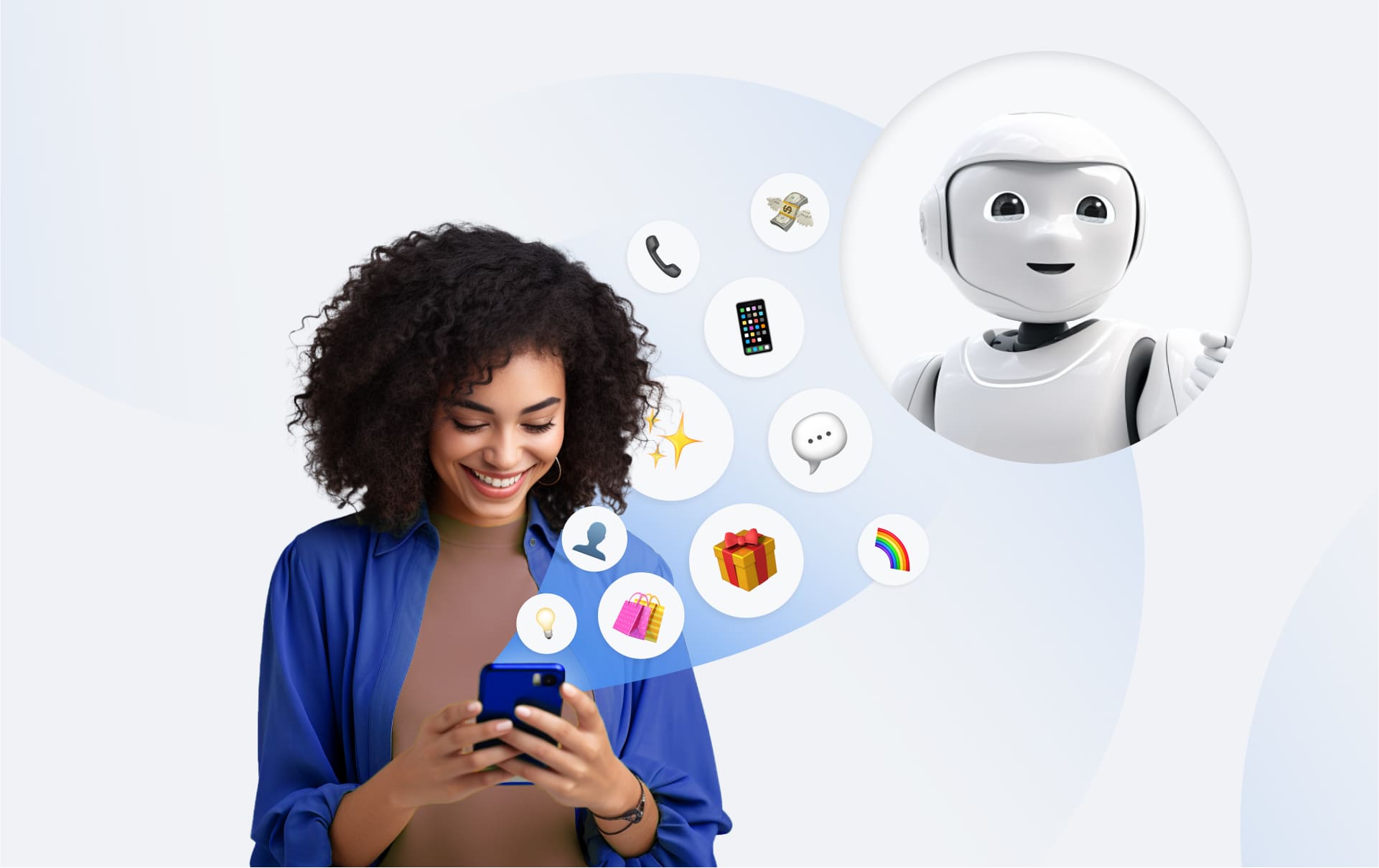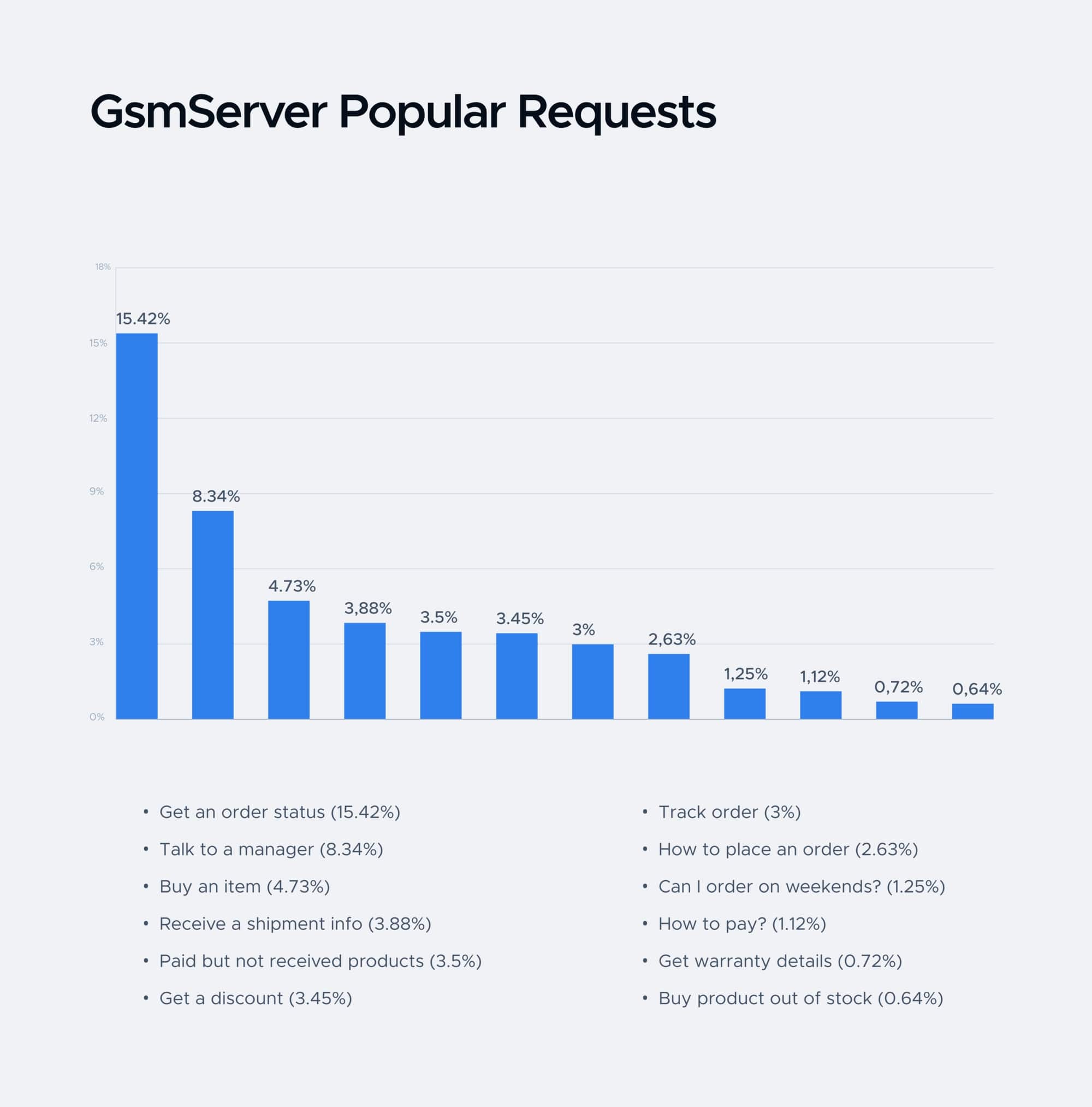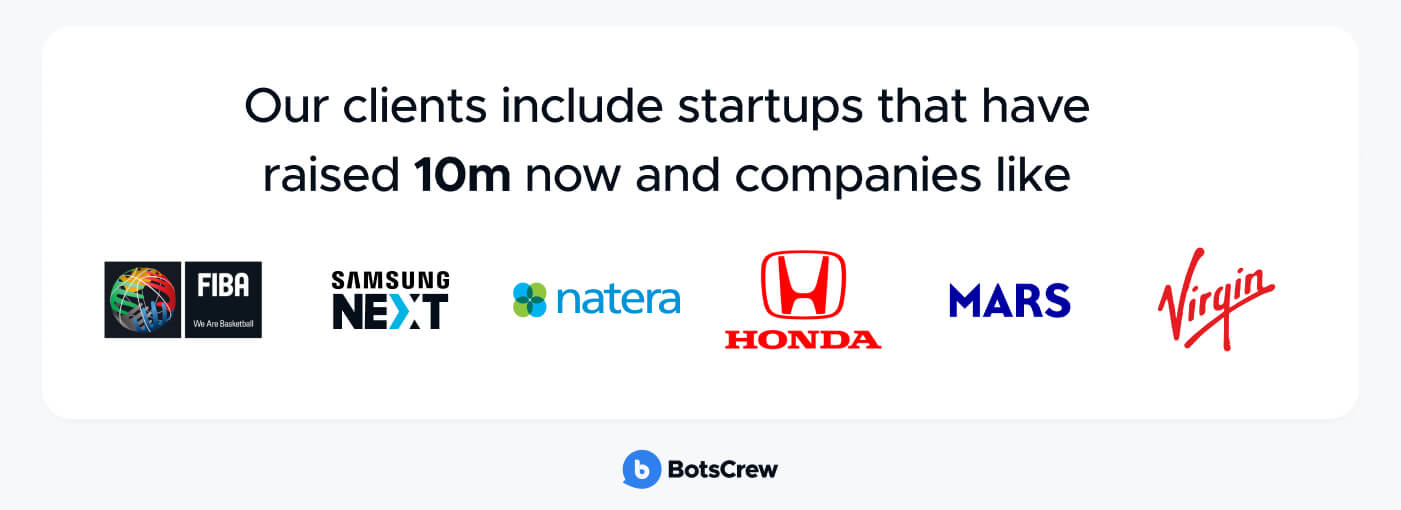Chatbots vs Humans: 4 Ways AI Chatbots Can Improve CX
Are AI-powered chatbots killing or enhancing customer satisfaction? Discover latest mind-blowing trends, statistics, and data on how chatbots improve customer experience through instant support, personalized content, and seamless human chatbot interaction, as well as help enterprises to grow their business and overall ROI.

How many times have you as a consumer sent off an email to customer service to receive a reply in X days (or even weeks)? Believe it or not, even if a customer service team at your company seems exceptional, it's worth always keeping in mind that consumer culture has drastically changed.
Nowadays, while sending off a question via social media, messengers, or email, consumers expect to receive an instant reply. Moreover, studies have shown that 80% of customers are willing to switch to a competitor if they encounter poor customer service and, accordingly, experience.
🤖💡If you are looking for a way to improve customer service, chatbots may be your secret weapon. According to Invespcro, 67% of consumers worldwide have interacted with chatbots at least once in the past 12 months.
Whether you are a small startup or a large enterprise, understanding the potential of the best customer service chatbots to improve customer experience can help you revolutionize your business. In this blog post, we will explore how AI chatbots can improve customer experience as well as discover chatbot best practices.
Customer Experience (CX) and An AI Chatbot: Research And Main Findings
AI-powered chatbots are capable of text and voice command inputs and outputs, identity management, speech recognition, and contextualization. This enables dialogue and handles various requests.
However, chatbots can not only answer potential clients' questions, but also transfer them into a sales message chain, accept an order, and transfer requests to the required company's department.
In addition, AI chatbots remember customer preferences, use historical data to recommend products and services, and deliver outstanding customer support. For tasks outside their capabilities, the AI-powered chatbot can escalate a customer to a live chat with a human advisor.

Chatbots vs Live Agents: How Do Customers Perceive Chatbots and What to Choose in the Modern Era?
Customers all over the globe consider chatbots and human support agents as one source of help which is confirmed by statistics:
23,3% of users rate a chatbot less than 3* when human support agents didn't reach out. Moreover, 27% of people rate chatbots negatively due to a human agent not helping with an issue.
26% of users rate a chatbot interaction positively if it connects them with human support and if agents solve their request/-s.
37% of customers reach a website chatbot or any other kind of chatbot and request a live agent when the technology fails to provide the right solution to their request.
🤔 "Okay, looks like my company needs live agents anyway. Do I still need a chatbot?" — you will probably ask. And we already have an answer to this in the form of convincing statistics:

AI-powered chatbots and live agents are a proven tandem toward the goal of delivering an upper-level customer experience. With the perfect balance, they can complement one another.
Chatbots can handle the simple, time-consuming tasks that do not require human input and then turn over the reins to human agents if the need for more comprehensive support is required. However, the technology has become even smarter with ChatGPT-4. Some advanced chatbots are even capable of detecting frustration in a customer's voice and subsequently offering to transfer the call to a live agent.
❗️ AI chatbots should augment, not replace, human interaction. Keep in mind that people often get annoyed when they are stuck in endless menus without the possibility of live communication. According to Zendesk's 2023 study, 71% of consumers fancy a real conversational experience.
For complex or sensitive situations that demand empathy and a human touch, customers should be able to escalate to personal — live — support to prevent customer frustration and maintain service quality.

Companies that use chatbots for customer service achieve 3.5 times greater increase in customer satisfaction rates. Are you ready to be among these companies and skyrocket your business?
Contact us to discuss your future chatbot project
How AI Chatbots Improve Customer Experience and Engagement: Key Findings and Latests Statistics
Deployed across the customer journey, AI-powered chatbots break down silos between marketing, sales, and customer service departments. They provide customers with personalized engagement as well as promote a high satisfaction level.
Those who are at the forefront of introducing the latest information technologies always receive additional benefits. Wherever you are on your chatbot journey, check out how AI chatbots improve customer experience:
#1. Speeding Up Response
We live in the age of convenience, where information is accessible 24/7 and everything is personalized. However, long wait times for inquiries in many industries are still one of the biggest problems that cause companies to keep losing customers.
A HubSpot survey shows customers' top 5 customer service pain points. The top #2 are waiting on hold (33%), and repeating information while being passed around different company’s departments (33%). Slow response times are a huge frustration, and AI chatbots can solve this since they are available 24/7.
Previously, when a person called support with a request, they were passed from one manager to another until someone managed to handle an issue. Today, with advanced chatbots, getting an answer is just a matter of seconds. In difficult case scenarios, the technology can quickly find a competent manager who can solve the request.

KLM Royal Dutch Airlines uses a chatbot to handle passenger queries. Within a year of using it, KLM was able to increase the number of clients by 40%, and the response time to requests was reduced by 50 times.
We've helped the world leader in hair, skin, and body care products creation named Legendary.cx, to automate 22.7% of end-to-end requests and speed up cosmetics client story resolution time x3 with GPT-3.5 implementation. In the result, it saved our customer over $20 thousand, or $19 per conversation.
In addition, as in the last five years, the brand has seen phenomenal growth which led to:
1.10M website monthly visitors.
Customer service response waiting time:
- 20 seconds first response;
- 2 minutes for follow up responses.
10m 33s average resolution time.
~282% growth of inquiries per year.
We integrated the chatbot with GPT-3.5 technology. During the first test results, we achieved a better chatbot quality of understanding questions, from 50% to 80%.
These days, the client agreed to proceed with further automation, up to 90% of customer support requests.
#2. Providing Personalized Service & Offers
Personalization is not a new trend, but today's consumers expect more personalized communication than ever. Personalization means treating customers as individuals with unique preferences, behaviors, and pain points, providing them with a unique experience. This can be anything from a custom landing page to product recommendations and consultations.

And this is where chatbots come into the game. By gathering and analyzing customer data, preferences, and pain points, AI chatbots can gain insights into individual customer needs and preferences, allowing them to tailor their requests and recommendations accordingly.
H&M created a Kik chatbot that provides customers with personalized outfit recommendations based on their preferences and styles. The company's chatbot also sends links to the recommended items, making it easy for customers to complete their purchases.
H&M's Kik chatbot achieved an 86% engagement rate, with users spending an average of 4 minutes interacting with it. The chatbot's click-through rate stood at 8%, surpassing H&M's email marketing click-through rate of 2%.
Bank of America created an AI assistant named Erica which provides customers with personalized financial advice and assistance on budgeting, and paying bills, among others. The most common uses of Erica now are monitoring subscriptions and bills and analyzing spending habits.
For example, clients check for merchant refunds 863,000 times per month and get FICO score updates 267,000 times. Generally, The Bank of America customers have interacted with its AI assistant Erica over 1.5 billion times since its 2018 debut. The AI-powered chatbot responds to more than 56 million requests per month.
Virgin Holidays figured out that the 3rd Monday of January is considered to be the most depressing day of the year. A British transatlantic tour operator and market leader for travel to the US and the Caribbean Virgin Holidays decided to shake away Monday's blues by launching the campaign "Screw It, Let's Do It" aimed at encouraging people to look at January as the perfect month for grabbing a new adventure. They slashed the prices of over 200 activities from its holiday packages to just $1 (basically the price of a chocolate bar!).
To promote the campaign and provide customers with personalized approaches, we at BotsCrew have been engaged in chatbot development that enhances personalization. We've created a messenger chatbot solution Virgin Holidays using a Californian ToV with its common slang words, expressions, and optimistic vibe. Together with Virgin Holidays and a partner PR company, we formulated the chatbot requirements, ideal user profile, user stories, and a project roadmap.
A Messenger chatbot chats with a user, collects the required info, and then recommends the activity or destination that would be a good match for this person. After that, a person can purchase the unique codes for each experience. For more details, check out our case study.

Use chatbots to proactively resolve potential problems. Transfer the user's communication history with the chatbot to CRM and prepare personalized offers. Calculate your savings with the customer service chatbot in a few seconds.
#3. Increasing Omnichannel Support and Streamlining User Experience
Buyers engage with companies on 13 different channels, most of which are disconnected. At the same time, a well-implemented omnichannel approach increases customer loyalty and creates a unified brand experience. In addition, it helps to increase profits — according to statistics, this way, customers spend 20% more money than buyers from the same channel.

Therefore, it's worth choosing a chatbot that you can deploy, for example, on WhatsApp, Facebook Messenger, your website, and your mobile application. An omnichannel chatbot provides customers with an integrated buying and customer support experience across all channels. It helps to reach out to your target audience wherever they are. With the AI-powered chatbot, you can centralize the data provided by customers from different channels.
In addition, with its help, you can align all customer service and channel activities in one direction to avoid duplication. Deploy a chatbot across different channels with a unified omnichannel platform to manage all customer support conversations.
Businesses can retain 89% of customers through an omnichannel strategy.
73% of consumers use multiple channels when they want to make a purchase.
About 80% of offline store customers browse online channels before or during a purchase decision.

#4. Empowering Self-Service
According to Zendesk, 67% of customers prefer self-service tools like AI chatbots to contact a live support agent. Moreover, a recent Gartner report shows that 70% of consumers use customer self-service portals to resolve their questions.
The autonomy to handle requests swiftly and on their terms is a significant shift from traditional service formats. This empowerment enhances satisfaction and alters consumer expectations. In addition, Gen-Z and millennial consumers prefer to be self-reliant when it comes to diagnosing and managing a problem.
The most frequently used self-service options include:
- FAQ pages. The frequently asked questions (FAQs) pages contain answers to the most common queries or links to other resources such as knowledge base articles, live chat and customer support, and other resources. However, if the chatbot is trained on the FAQ section, the user won't have to search for the answer himself. The chatbot can work with both voice and text, and be trained on various content types.
Create a Free Custom GPT-4 Chatbot Prototype and Start Taking Your Business to a New Level by Responding to Market Trends and User Requests!
- Knowledge base. According to Asksuite, 91% of consumers would use an online knowledge base if it were available and tailored to their needs. Knowledge-based materials contain detailed information for resolving common issues. Customers can search for relevant articles or videos using the company's web page or search section. AI-powered chatbots with knowledge bases can cut down the search time and refine search results.
- Voice automation. When the customer contacts the support center, they usually can solve their requests without talking to a human agent. An IVR technology powered by natural language processing (NLP) and artificial intelligence can answer most queries and forward the call to a live agent if needed.
- AI chatbots. The chatbots have taken over answering queries for most companies with an online presence. AI-powered bots can connect with consumers across multiple platforms such as websites, social media profiles, instant messengers, and mobile applications.
We've developed a website chatbot named Basky that answers general and more specific questions about products, provides information about orders, and helps customers buy items. It easily connects them with a real human if you do not get your answer.
Our client is a multi-range international online store, where you can conveniently purchase telecommunication-related technological solutions, STEM equipment, accessories for cell phones, repair/service tools, etc.
The customer and technical support were overloaded with repetitive requests. Some user flows on the website, like the account's password recovery, were too complicated and stopped customers from quick resolutions. Besides, the team worked only during the weekdays and till the afternoon on Saturdays, and, it turned out, that it did cause problems for their customers.
After six months after solution deployment, the chatbot automated 72.28% of all customer requests.

Check out other chatbot use cases for different industries, and let's discuss the solution that's perfectly tailored to your sector and business needs!
Reap The Benefits of Chatbots with BotsCrew
Chatbots are a competitive differentiator that can enhance customer engagement and satisfaction for brand loyalty, improve retention rates, and increase Customer Lifetime Value (CLTV). These AI bots create an undeniable win-win for companies and their customers alike.
Consumers accustomed to excellent AI-powered chatbot experiences with one company will expect no less from others, setting a high bar for all players in the sector. Staying ahead requires constant innovation and a strong ability to adapt strategies as AI technology, chatbot solutions, and customer expectations continue to evolve.
Optimize your customer journeys with BotsCrew! Give your agents the time to build more personal relationships with customers and each customer — an experience that puts them first.
Our AI-powered solutions allow you to go beyond traditional services. This is the key to automating processes, fast and personalized support, and effective communication with your customers.
Handle simple user requests without human agents 24/7
The chatbot will instantly answer the user's questions. This way, customers won't have to wait in line or listen to a voice menu, and the support team can focus on helping with non-routine issues. You can support your customers 24/7 and avoid night shifts for your employees.
Synchronize the work of chatbots and live agents
Find the right balance between chatbot and live chat support. This way, you can relieve the support team and at the same time offer customers fast and high-quality service.
Reduce support team costs
Chatbots can participate in an unlimited number of simultaneous conversations, allowing you to reach SLA targets without additional costs.
How do we create successful chatbots? At BotsCrew, we can build a customized chatbot that satisfies your business needs and improves the way you engage with customers.
Since there is no one-size-fits-all and each company has unique goals and challenges, we create a custom solution tailored to your brand, business goals, market, platforms, tech stack, and client base for the best results. Our team supports you from the chatbot idea to its launch and then from improvement to scaling.

Why should you trust us? Since 2016, we've created over 100 chatbots on Facebook, WhatsApp, Website, among others for more than 80 companies from all over the world. Our clients include startups that have raised 10m now and companies like Samsung NEXT, Mars, Natera, Virgin, and Honda.
Deliver instant support to your customers at scale








